Gesmatbewertung: 7/10 Detailbewertungen am Ende des Berichts | Vergleich aller Wettkämpfe
When you decide to live in Eastern Ontario, you made your peace with winter running, and even start enjoying it at some point. I’ve lived in Ottawa for more than six years now and got used to running in cold, snowy weather between December and April. This marathon, though, happened to take place in the middle of this region’s heaviest blizzard in decades and turned out to become one of my most memorable race experiences.
Tough conditions!
The first time I ran this marathon was in 2022 (see race report). Organized by our local multi-sport racing series Somersault, it again promised to be a well-run event. And a cold one, too! This year’s winter had been a challenging one, with temperatures in the double digit negatives basically since the end of December, and plenty of snow coming down just a couple days prior to race day; with another blizzard forecasted for the morning of. Ten years ago, this would have been bad news for me; today, I’ll take the challenge. When marathon running has become almost somewhat of an endurance routine, you really start embracing the more challenging circumstances, knowing that memories created by tough conditions will last so much longer.
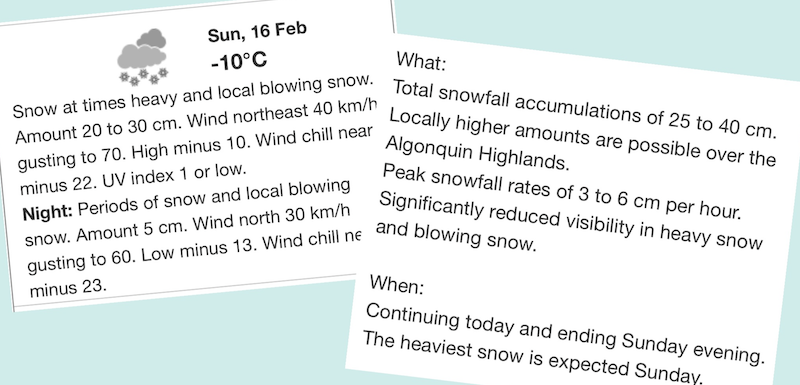
Local events are the best
The beauty or participating in local events is that your morning routine doesn’t have to be adapted much, and in this case, the starting line was just a short bike ride away from where I live. After an early Sunday breakfast at home I took my commuter bike and made my way through strong winds and unplowed sidewalks down the road towards the Canadian War Museum, which hosted the event and provided all the heated amenities everyone appreciates in weather like this. Space to leave your change of clothes for after the race, clean indoor washrooms, and areas for everyone to just keep warm before the race would start. I had about 30 minutes to meticulously prepare myself for what was to come: applying a layer of vaseline onto my exposed face skin; attaching the bib number to my race belt; having a banana and hydrating with 500ml of fluid electrolytes; protecting my head with all the scarfs and hats and hoodies; and finally, checking my GoPro camera – this year would be the first time that I’d try filming a long distance race.
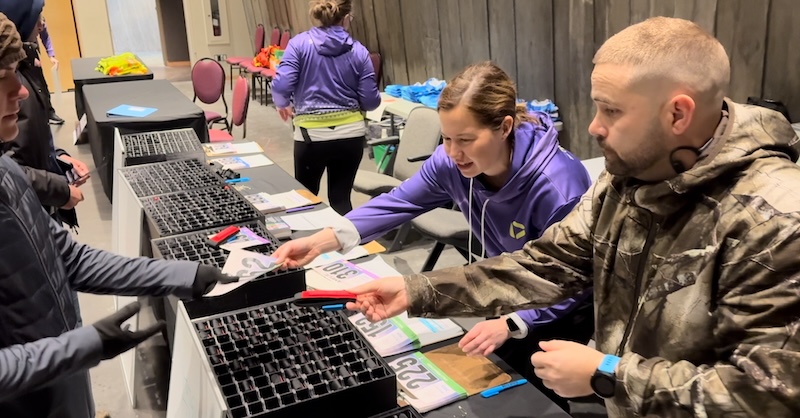
Only 35 marathoners made it to the starting line (out of well over 100 registered athletes), due to the weather forecast. Others were drawn to this race not despite, but because of the conditions: I chatted with a seasoned athlete from Connecticut, who only made his way to Ottawa to experience running in awfully snowy and cold conditions. He definitely got what he came here for!
The course
Normally I’m not the biggest fan of multi-loop courses. For this type of event, though, it totally makes sense. When it’s freezing cold and plenty of snowfall is forecasted, you don’t want a small group of runners spread across a huge distance. Managing water stations with just a few volunteers is also much easier on an eight-loop course, and much less effort is needed to secure the route, while snow removal and car traffic is not effected too heavily.
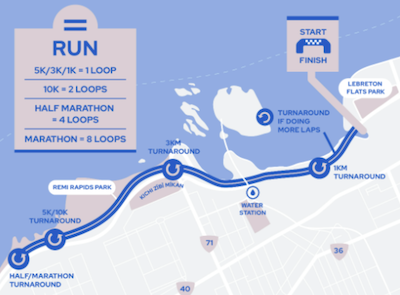
(map from somersault.ca)
The starting line was just a short walk away from the museum, on Kichi Zibi Mikan. After running up a short hill, runners would then follow the parkway along the Ottawa river to then turn around after 2.5 kilometers until back up the hill. This 5 kilometers out-and-back loop was to be done eight times, before returning to the start/finish line. There was one hydration station placed on the road, where brave volunteers would be serving water, electrolyte drinks, and Xact bars.
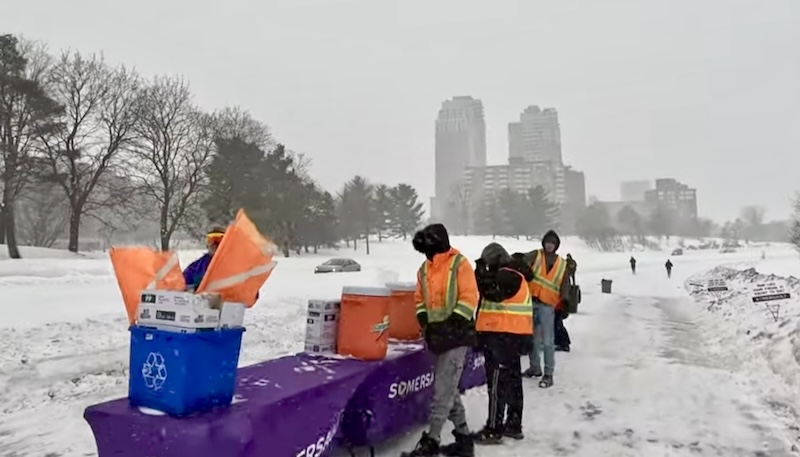
The first 10k
The snow storm was in full swing when all 35 runners gathered at the starting line just minutes before 8am. Race director Adam provided some final instructions while everyone seemed to be eager to start running and fighting the freezing temperatures. Right on top of the hour we were let go onto our individual journeys over the next 42.2 kilometers.
A tailwind was blowing strongly from an easterly direction, pushing us westwards, and making the first miles feel rather easy. My body warmed up quickly, up to the point that I even felt overdressed. I was in a good mood, as always, when a race finally starts. All the self-doubts and race anxieties are washed away as soon as you cross the starting line. Now, everything is just about the moment and figuring out your rhythm. For the first marathon of the season, my goal was basically just finishing while having fun as long as possible. I’ve done quite a bit of running in harsh conditions, but today’s blizzard was predicted to worsen over the morning hours – any competitive race goal for me was out of question. And it became clear relatively quickly, that the snow-covered road would make the footing extra sketchy, requiring much more effort for every single step.
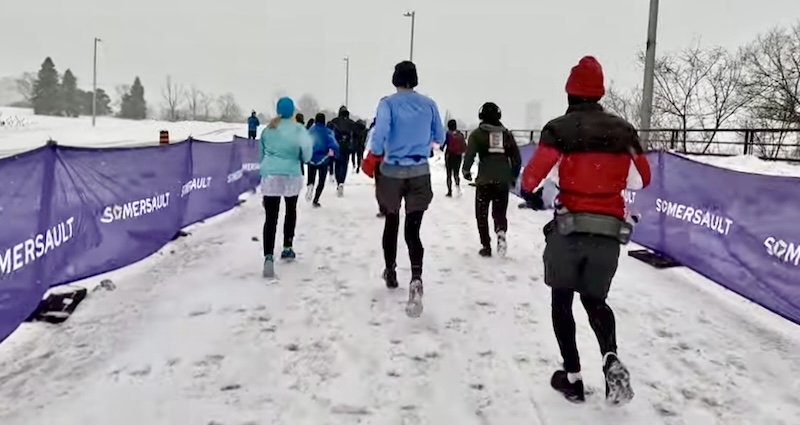
Just after the first turnaround at 3 kilometers, reality hit me like an icy slap to the face—literally. The headwind, which had been lying in wait, wasted no time draining my warmth and momentum. On the bright side, my energy was still up, and I decided to frame this sudden spike in suffering as a “fun challenge.” After all, there was another turnaround in just 15 minutes. That’s what I kept telling myself, anyway.
Then came the hill. Not a mountain by any means, but still the kind of incline that makes you question your life choices—especially when paired with a snowstorm and footing that felt like running on a half-melted Slurpee. I remembered it well from the last two years’ half marathons, though back then, I only had to endure it once. The thought of climbing it seven more times today sounded almost like an impossible feat at this time.
Reaching the top was a relief, if only because it meant I wasn’t stuck on that hill forever. A couple hundred meters ahead, I spotted the next turnaround, and to my surprise, a small group of spectators had gathered. These brave souls stood behind the cones, cheering for each frozen, wind-battered runner who passed. A welcome distraction for me on an otherwise rather quiet course. Then again, watching 35 slightly unhinged marathoners voluntarily run through a snowstorm provided its own form of entertainment. Hats off to all of them, for making some questionable decisions that day!
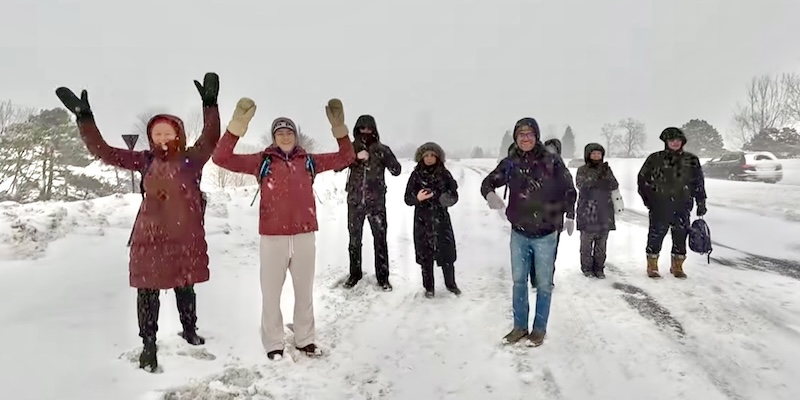
After grabbing a few quick sips of electrolytes at the water station near the bottom of the hill, I settled back into a steady pace — around 5 minutes per kilometer. So far, so good. The second loop still felt manageable, though the footing was already starting to degrade, transforming from “lightly packed snow” to something closer to a very poorly maintained ice rink. To keep my mind occupied, I filmed parts of the course, some of the other runners, and myself — offering semi-insightful reflections like, “Well, this is getting worse.”
Mid-race: harder than expected
And getting worse it was. More snow was coming down and piling up on the road surface. The small patches of snow-free asphalt, exposed by the wind, kept disappearing. The constant sliding and slipping caused blisters starting to form on one of my big toes, and I wasn’t even half way through. While the ice shield in my face slowly grew bigger (and actually protecting my otherwise exposed skin from the windchill), the rest of my body started to get colder. How would I ever be able to sustain the uncomfortable mix of exhaustion, pain, and hypothermia for another two hours?
I had run 22 marathons prior to this race, most of which just in recent years. After plenty of long-distance running experience you’ve learned a couple of fundamental truths about the sport and yourself doing it. My most important insight from almost every race: Only because something feels awful now, does not mean it will still feel awful in 10 minutes from now. Weirdly, discomfort comes and goes. Sometimes it first gets worse before it gets better, and sometimes it won’t get better at all. Often enough, though, you just need to focus on the very moment, the next 500 meters, the next turnaround, or the next hill, and before you realize, the biggest pain may be gone, or even just replaced by a different, less severe pain.
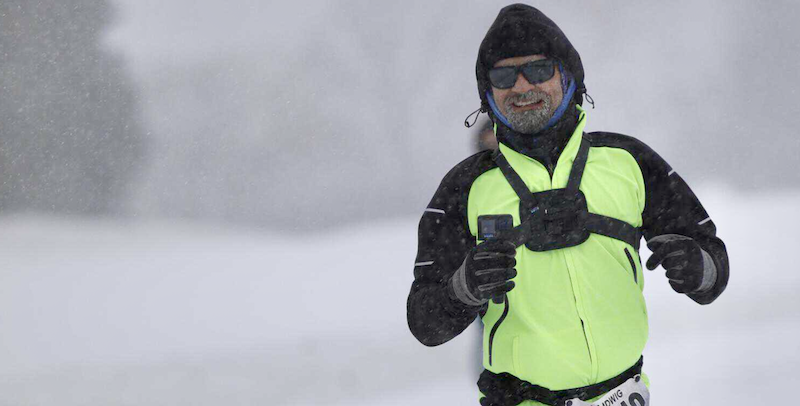
And yet, I had to acknowledge that today’s conditions were harder than during many of my previous marathons; as expected. After about twenty kilometers my pace started to slow down substantially. Loop after loop, including that sufferfest of a hill at the end of each one, I counted down how many more were left. The course became more crowded for a while, with now half-marathoners and 10k-runners on the road as well. The out-and-back route design allowed to actually see familiar faces coming towards you and it always lifts the spirit when you can high-five a friend coming towards you, fighting through the same blizzard.
Finishing project blizzard marathon
Loop after loop I came closer to ending this adventure. Each time I passed the one water station I slowed down, grabbed one or two cups of water after determining its fluid, non-frozen state. Drinking gets more complicated when your facial muscles can hardly move due to the cold, and my beard icicles were getting bigger and bigger – partly from sweat, partly from snow, partly from electrolyte-drinks dripping down my chin.

Soon enough my whole face was literally covered in ice, but only when I saw myself after the race I actually realized how ridiculously epic I looked during those final couple loops on the course. The snowstorm had picked up, the road was almost unrunnable at this point. Going up that gruesome hill the eighth and final time felt great, though! I looked at my Garmin watch, realizing that I’d likely finish under four hours if I kept the pace for the last 1000 meters and sure enough I crossed that finish line at 3:59:43. Marathon number 23 was in the books! And this one was definitely one to remember.
Project blizzard marathon accomplished. First of my age group (consisting of three in total), and seventh overall.
Nachbetrachtung
- Second winter marathon, and the second time in very challenging conditions
(after Winterman 2022) - Somersault runs are perfectly organized yet local events every athlete in the region should check out. Thanks Adam for putting so much effort into it!
- My nutrition game is getting much better. In 2022 I learned, that bringing along hydration on a run at -15ºC or colder does not make sense. I stuck to on-course nutrition only, drinking electrolytes regularly and eating three Xact bars.
- Running in challenging conditions is unbelievably rewarding and give you an even higher sense of accomplishment than a ‘regular’ marathon.
- Next up: Kulturhauptstadt-Marathon in my German hometown of Chemnitz, in about 12 weeks!
Statistiken
Gesamtstrecke: 42.2km
Gesamtzeit: 3h59m (compared to 3h04m personal best)
Herzfrequenz: 160bpm
Gesamte Höhe: 300m
Verbrannte Kalorien: 3000
Konsumierte Kalorien: 300
Flüssigkeit aufgenommen: 900ml
Temperatur: -10ºC (-20ºC windchill)
Total number of registered runners: 560 (35 of which were marathoners)
Somersault Embrace Winter Marathon Ottawa, ON, Canada | |||
Overall rating | |||
 | 2025 |  | 35 |
 | Winter |  | 8 Runden |
 | 8:00AM |  | Rolling (250m) |
 | -15ºC |  | Snow |
Individual ratings* | |||
Spectators | Scenery & views | ||
On-course nutrition | Overall organization | ||
Medal design | Finisher shirt | ||
Timing and splits | Value | ||
What stood out Crazy weather this year (blizzard). Very well organized and the volunteers are tough for being there! No timing mats at the turnarounds, so no splits available. | |||
*Einzelne Bewertungen: Details siehe unten
Die Bewertungen sind sehr subjektiv sind und basieren nur auf dem letzten Lauf, den ich persönlich durchgeführt habe. Einige Dinge wie das Design der Medaille oder des Finisher-Shirts können von Jahr zu Jahr stark schwanken.
Zuschauer: Wie viele Zuschauer entlang der Strecke? Wie viel Action und willkommene mentale Ablenkung für die Läufer, insbesondere in der zweiten Hälfte der Strecke, wurde geboten? Höhere Bewertungen für mehr Zuschauer, Action, Musik, etc.
Strecken-Verpflegung: Anzahl der Wasserstationen und Vielfalt des Nahrungsangebots.
Medaillen-Design: Wichtige Aspekte für mich: Spiegelt die Medaille in gewisser Weise den Ort oder die Strecke wider? Zeigt sie die Distanz und das Datum der Veranstaltung? Hat sie eine angemessene Größe und Form? Wie kreativ ist das Design? Sieht sie billig aus?
Zeitmessung: Wie viele Zeitmessmatten gab es auf der Strecke? Gab es Zeitmessungsmatten in Schlüsselbereichen, um Abkürzungen zu verhindern und Zeitsplits zu ermöglichen?
Umgebung/Aussicht: Wie viel visuelle Ablenkung und Staunen bekommt man als Läufer auf der Strecke? Normalerweise bieten Ein-Runden- oder Punkt-zu-Punkt-Läufe mehr Abwechslung im Vergleich zu Strecken mit mehreren Schleifen. Ich schätze natürliche Landschaften mehr als Industrie- oder Vorstadtgebiete.
Organisation insgesamt: Wie gut war die Veranstaltung insgesamt organisiert? Inklusive Kommunikation vor und nach dem Event, verfügbare Streckeninformationen, Expo, Neben-Events, Ansagen vor und nach dem Rennen, Start- und Zielbereich, usw.
Finisher-Shirt: Das Design des Shirts, die Art des Stoffes, ist es voll von Sponsoren?
Wertigkeit: What you get vs what you paid. Some races are super expensive and you don’t even get a shirt, others are reasonably priced and even include a pasta party the day before. High ratings either mean cheap entry or lots of goodies.

